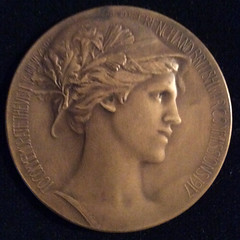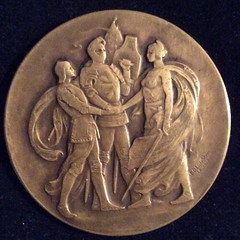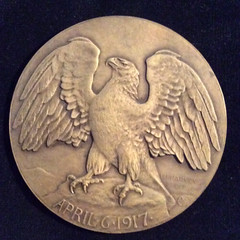
PREV ARTICLE
NEXT ARTICLE
FULL ISSUE
PREV FULL ISSUE
AMERICA'S WWI ENTRANCE MEDALSAuthor Richard Jewell of the Pennsylvania Association of Numismatists sent me a copy of his article on the medals of America's entrance into WWI. Thanks. Here's an excerpt.
The article will be featured on the cover of the May 2017 issue of The Clarion, PAN's official publication. -Editor
Centennial of The United States of America’s Entrance Into World War I (A Medallic Tribute) Finally after years of attempting to keep us out of the war in Europe President Woodrow Wilson on the 6th of April 1917 asked Congress to declare war on Germany. His patience having been exhausted in his dealings with the Imperial German Government and the American people having been stirred up by a series of incidents including the sinking of the Lusitania and the Zimmerman note, the time had come for America’s entrance into the War to end all Wars. Declaration of War Medal
French Premier Alexandre Ribot sent a mission to the United States soon after President Wilson asked Congress to declare war. The French Mission contained both political and military representatives of the Third Republic. Their reason for existence was to coordinate American participation in the Great War. The member of the mission, who stood out the most to the leaders of the Wilson Administration, the Congress and the U.S. Army, as well as the American people, was Marshall Joseph Joffre. For many Americans, Joffre personified both France and her Army as the “Hero of the Marne.” The British, not to be out done by their French counterparts, also sent a similar contingent. The British and French War Commissions Visit to New York City Medal, 1917
  The medal was bronze and had a diameter of 2-1/2 inches. The legend surrounding the rim reads: “TO COMMEMORATE THE VISIT TO NEW YORK OF THE FRENCH AND BRITISH WAR COMMISSIONS 1917.” The reverse design was created by French’s former assistant, and ANS member, Evelyn B. Longman. Her creation is modeled in a more streamlined, hard-edged style, but still features an allegorical configuration of three figures. Joan of Arc represents France; a medieval knight represents England and a flowing draped Lady Liberty, with sword in hand representing the United States coming to the aid of all Europe. I'll stop here, but there's much more to the article, which covers some dozen medals in all. Here's the article's conclusion. -Editor
These are just a few of the many World War I medals issued during or following the Great War to Save Civilization. Although the War may have ended a “Renaissance of the American medal,” per Barbara Baxter, it did not stop the energy of the medalists of the world. If nothing else it opened the era of Art Deco and beyond. America would have Victor David Brenner for four more years, James Earle Fraser was here and doing some of his finest work as was his wife and fellow sculptor Larua Gardin Fraser, Julio Kilenyi was in the wings ready to become the next Brenner. Paul Manship was going to produce a few more medals in between his sculpture commissions, John Flanagan was continuing to design medals and coins, Anthony de Francisci was doing fine medallic work as well. America was in very capable hands and on the continent you had the likes of Godefroid Devreese in Belgium, Karl Goetz in Germany, Pierre Turin, Jules Prosper Legastelois, Alexandre Morlon, Marcel Dammann and Maurice Delannoy in France to carry on and influence the future of medallic art. Richard contributed a score of medals to the American Numismatic Association's "Trenches to Treaties" exhibit in Colorado Springs, opening May 18th. -Editor
For more information on the Pennsylvania Association of Numismatists, see:
Wayne Homren, Editor The Numismatic Bibliomania Society is a non-profit organization promoting numismatic literature. See our web site at coinbooks.org. To submit items for publication in The E-Sylum, write to the Editor at this address: whomren@gmail.com To subscribe go to: https://my.binhost.com/lists/listinfo/esylum All Rights Reserved. NBS Home Page Contact the NBS webmaster 
|
